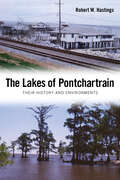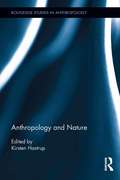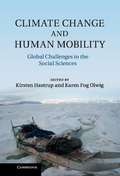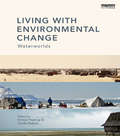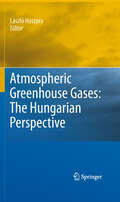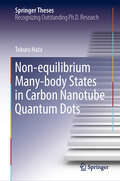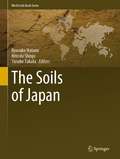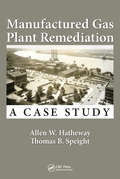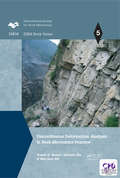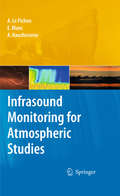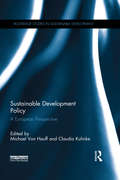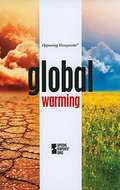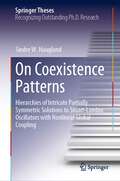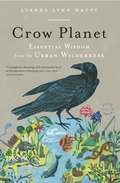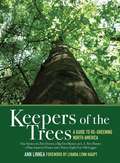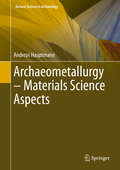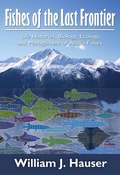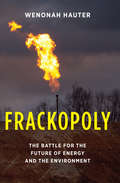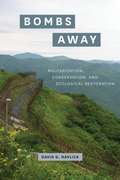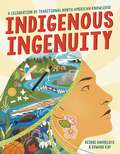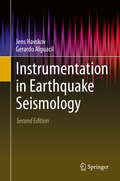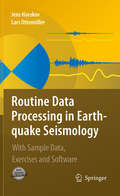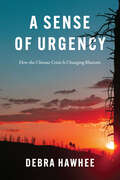- Table View
- List View
The Lakes of Pontchartrain: Their History and Environments
by Robert W. HastingsA vital and volatile part of the New Orleans landscape and lifestyle, the Lake Pontchartrain Basin actually contains three major bodies of water—Lakes Borgne, Pontchartrain, and Maurepas. These make up the Pontchartrain estuary. Robert W. Hastings provides a thorough examination of the historical and environmental research on the basin, with emphasis on its environmental degradation and the efforts to restore and protect this estuarine system. He also explores the current biological condition of the lakes. Hastings begins with the geological formation of the lakes and the relationship between Native Americans and the water they referred to as Okwa'ta, the “wide water.” From the historical period, he describes the forays of French explorer Pierre Le Moyne D'Iberville in 1699 and traces the environmental history of the basin through the development of the New Orleans metropolitan area. Using the lakes for transportation and then recreation, the surrounding population burgeoned, and this growth resulted in severe water pollution and other environmental problems. In the 1980s, the Lake Pontchartrain Basin Foundation led a concerted drive to restore the lakes, an ongoing effort that has proved significant.
Anthropology and Nature (Routledge Studies in Anthropology #14)
by Kirsten HastrupOn the basis of empirical studies, this book explores nature as an integral part of the social worlds conventionally studied by anthropologists. The book may be read as a form of scholarly "edgework," resisting institutional divisions and conceptual routines in the interest of exploring new modalities of anthropological knowledge making. The present interest in the natural world is partly a response to large-scale natural disasters and global climate change, and to a keen sense that nature matters matters to society at many levels, ranging from the microbiological and genetic framing of reproduction, over co-species development, to macro-ecological changes of weather and climate. Given that the human footprint is now conspicuous across the entire globe, in the oceans as well as in the atmosphere, it is difficult to claim that nature is what is given and permanent, while people and societies are ephemeral and simply derivative features. This implies that society matters to nature, and some natural scientists look towards the social sciences for an understanding of how people think and how societies work. The book thus opens up a space for new forms of reflection on how natures and societies are generated.
Climate Change and Human Mobility
by Kirsten Hastrup Karen Fog Olwig'The greatest single impact of climate change could be on human migration', stated the Intergovernmental Panel on Climate Change (IPCC) in 1990. Since then there has been considerable concern about the large-scale population movements that might take place because of climate change. This book examines emerging patterns of human mobility in relation to climate change, drawing on a multidisciplinary approach, including anthropology and geography. It addresses both larger, general questions and concrete local cases, where the link between climate change and human mobility is manifest and demands attention – empirically, analytically and conceptually. Among the cases explored are both historical and contemporary instances of migration in response to climate change, and together they illustrate the necessity of analyzing new patterns of movement, historic cultural images and regulation practices in the wake of new global processes.
Living with Environmental Change: Waterworlds
by Kirsten Hastrup Cecilie RubowClimate change is a lived experience of changes in the environment, often destroying conventional forms of subsistence and production, creating new patterns of movement and connection, and transforming people’s imagined future. This book explores how people across the world think about environmental change and how they act upon the perception of past, present and future opportunities. Drawing on the ethnographic fieldwork of expert authors, it sheds new light on the human experience of and social response to climate change by taking us from the Arctic to the Pacific, from the Southeast Indian Coastal zone to the West-African dry-lands and deserts, as well as to Peruvian mountain communities and cities. Divided into four thematic parts - Water, Landscape, Technology, Time – this book uses rich photographic material to accompany the short texts and reflections in order to bring to life the human ingenuity and social responsibility of people in the face of new uncertainties. In an era of melting glaciers, drying lands, and rising seas, it shows how it is part and parcel of human life to take responsibility for the social community and take creative action on the basis of a localized understanding of the environment. This highly original contribution to the anthropological study of climate change is a must-read for all those wanting to understand better what climate change means on the ground and interested in a sustainable future for the Earth.
Atmospheric Greenhouse Gases: The Hungarian Perspective
by László HaszpraHuman induced global climate change is the biggest challenge humankind faces today. Increasing amount of atmospheric greenhouse gases play a crucial role in the evolution of the climate. Without the understanding of the contributing processes, feedbacks and interactions we cannot predict the future changes and develop effective mitigation strategies. To decrease the uncertainty of the global studies detailed regional studies are needed surveying the regional characteristics of the atmospheric greenhouse gas budget and the influencing factors. Atmospheric Greenhouse Gases: The Hungarian Perspective covers a coherent subset of the Hungarian climate change oriented research that is directly related to greenhouse gases. Topics discussed in the book range from the monitoring of the concentrations and fluxes of atmospheric greenhouse gases, through the modeling of atmosphere-biosphere interaction and greenhouse gas exchange processes, to the review of the anthropogenic contribution of Hungary to the greenhouse gas budget of the atmosphere. The studies call the attention to the regional properties which may modulate the European scale or global picture on the variation of atmospheric greenhouse gases.
Non-equilibrium Many-body States in Carbon Nanotube Quantum Dots (Springer Theses)
by Tokuro HataThis book presents the first experiment revealing several unexplored non-equilibrium properties of quantum many-body states, and addresses the interplay between the Kondo effect and superconductivity by probing shot noise. In addition, it describes in detail nano-fabrication techniques for carbon nanotube quantum dots, and a measurement protocol and principle that probes both equilibrium and non-equilibrium quantum states of electrons. The book offers various reviews of topics in mesoscopic systems: shot noise measurement, carbon nanotube quantum dots, the Kondo effect in quantum dots, and quantum dots with superconducting leads, which are relevant to probing non-equilibrium physics. These reviews offer particularly valuable resources for readers interested in non-equilibrium physics in mesoscopic systems. Further, the cutting-edge experimental results presented will allow reader to catch up on a vital new trend in the field.
The Soils of Japan (World Soils Book Series)
by Ryusuke Hatano Hitoshi Shinjo Yusuke TakataThis book provides an overview of the distribution, properties, and function of soils in Japan. First, it offers general descriptions of the country’s climate, geology, geomorphology, and land use, the history of the Japanese soil classification system and characteristics and genesis of major soil types follow. For each region – a geographic/administrative region of the country – there is a chapter with details of current land use as well as properties and management challenges of major soils. Maps of soil distribution, pedon descriptions, profile images, and tables of properties are included throughout the text and appendices.
Wind Is to Feel
by Shirley Cook HatchWIND IS TO FEEL has many observations about the wind, and suggestions for activities that boys and girls an do on their own or with a parent or teacher.
Manufactured Gas Plant Remediation: A Case Study
by Allen W. Hatheway Thomas B. SpeightThe assessment, remediation, and redevelopment of manufactured gas plant (MGP) sites pose a significant technical and financial challenge to successor property owners, including municipalities and other public entities undertaking brownfields revitalization, and to their consulting environmental engineers. Due to the toxicity of many coal tar constituents, sites contaminated as a result of gasworks operations pose a significant threat to public health. This book will discuss the history of the manufactured gas industry in Massachusetts (the largest in the US), as well as the toxicity of gasworks waste products, technical challenges in the cleanup process, and the process for site cleanups.
Discontinuous Deformation Analysis in Rock Mechanics Practice (ISRM Book Series)
by Yossef H. Hatzor Guowei Ma Gen-hua ShiThe numerical, discrete element, Discontinuous Deformation Analysis (DDA) method was developed by Dr. Gen-hua Shi while he was working at the University of California, Berkeley, under the supervision of Prof. Richard E. Goodman in the late 1980s. Two-dimensional DDA was published in 1993 and three-dimensional DDA in 2001. Since its publication DDA has been verified, validated and applied in numerous studies worldwide and is now considered a powerful and robust method to address both static and dynamic engineering problems in discontinuous rock masses.In this book Yossef H. Hatzor and Guowei Ma, co-chairs of the International Society for Rock Mechanics (ISRM) Commission on DDA, join Dr. Shi in authoring a monograph that presents the state of the art in DDA research. A comprehensive discussion of DDA development since its publication is provided in Chapter 1, followed by concise reviews of 2D and 3D DDA in chapters 2 and 3. Procedures to select geological and numerical input parameters for DDA are discussed in Chapter 4, and DDA validation and verification is presented in Chapter 5. Applications of DDA in underground and rock slope engineering projects are discussed in chapters 6 and 7. In Chapter 8 the novel contact theory recently developed by Dr. Shi is published in its complete form, for the first time. This book is published within the framework of the ISRM Book Series and is the contribution of the ISRM DDA Commission to the international rock mechanics community.
Infrasound Monitoring for Atmospheric Studies
by Alain Hauchecorne Alexis Le Pichon Elisabeth BlancThe infrasound field, the science of low-frequency acoustic waves, has developed into a broad interdisciplinary field encompassing academic disciplines of physics and recent technical and scientific developments. In 1996, the United Nations General Assembly adopted the Comprehensive Nuclear-Test-Ban Treaty (CTBT), prohibiting atmospheric nuclear explosions worldwide. The infrasound network of the International Monitoring Network (IMS) of the CTBT-Organization has demonstrated its capability for detecting and locating infrasonic sources such as meteorites, volcanic eruptions, earthquakes, auroras, mountain associated waves... Nearly 70% of the global network is now operational and regional cluster arrays are deployed around the globe. Systematic investigations into low-frequency acoustic signals have evidenced an unprecedented potential of the monitoring of infrasonic waves permanently generated by natural and man-made events. Furthermore, recent studies point out new insights on quantitative relationships between observables and atmospheric specifications, and therefore opening new fields into the mathematics of geophysical inverse problems for atmospheric remote sensing. This volume reviews the most important areas of infrasound, with emphasis on the latest researches and applications, e.g. instrumentation, engineering, signal processing, source monitoring, propagation modeling, atmospheric dynamics, global changes, remote sensing methods. Researchers and students will benefit from a comprehensive content of infrasound related topics, where both fundamental and applied topics are discussed by authors from international institutions, all experts in their fields.
Sustainable Development Policy: A European Perspective (Routledge Studies in Sustainable Development)
by Michael Von Hauff Claudia KuhnkeSustainable Development Policy: A European Perspective uses a variety of multidisciplinary perspectives to explore the ways in which sustainable infrastructures can play a more prominent and effective role in international development policy. Building on a solid introduction to sustainability and development policy, this book discusses ways in which viable reform can be promoted through coherent governing, the design of social security systems, education systems and the possibilities of fair trade as an alternative trading concept . Sustainable Development Policy generates a platform on which to encourage constructive dialogue on issues surrounding sustainability in the wake of the global scarcity of natural and economic resources. This edited collection will be of great interest to all students and lecturers of development studies and development policy, as well as researchers from other disciplines looking for an introduction to sustainable development policy and its practical applications.
Global Warming (Opposing Viewpoints)
by David M. HaugenThe book discusses the opposing views on the subject of Global Warming under the heads: Is Global Warming a Real Phenomenon?, What Causes Global Warming?, What Is the Impact of Global Warming?, and How Can Global Warming Be Mitigated?
On Coexistence Patterns: Hierarchies of Intricate Partially Symmetric Solutions to Stuart-Landau Oscillators with Nonlinear Global Coupling (Springer Theses)
by Sindre W. HauglandThis book is about coexistence patterns in ensembles of globally coupled nonlinear oscillators. Coexistence patterns in this respect are states of a dynamical system in which the dynamics in some parts of the system differ significantly from those in other parts, even though there is no underlying structural difference between the different parts. In other words, these asymmetric patterns emerge in a self-organized manner. As our main model, we use ensembles of various numbers of Stuart-Landau oscillators, all with the same natural frequency and all coupled equally strongly to each other. Employing computer simulations, bifurcation analysis and symmetry considerations, we uncover the mechanism behind a wide range of complex patterns found in these ensembles. Our starting point is the creation of so-called chimeras, which are subsequently treated within a new and broader context of related states.
Crow Planet: Essential Wisdom from the Urban Wilderness
by Lyanda Lynn HauptThere are more crows now than ever. Their abundance is both an indicator of ecological imbalance and a generous opportunity to connect with the animal world. CROW PLANET reminds us that we do not need to head to faraway places to encounter "nature." Rather, even in the suburbs and cities where we live we are surrounded by wild life such as crows, and through observing them we can enhance our appreciation of the world's natural order. CROW PLANET richly weaves Haupt's own "crow stories" as well as scientific and scholarly research and the history and mythology of crows, culminating in a book that is sure to make readers see the world around them in a very different way.
Keepers of the Trees: A Guide to Re-Greening North America: True Stories of a Tree Doctor, a Big Tree Hunter, an L.A. Tree Planter, a Plant Amnesty Pruner, and a Ninety-Eight-Year-Old Logger
by Lyanda Lynn Haupt Ann LinneaEngage in the life stories of fourteen people whose lives have been shaped by trees-featuring the true stories of a tree doctor, big tree hunter Will Blozan, Plant Amnesty's pruner, and ninety-four-year-old logger Merve Wilkinson. Also interviewed is Vietnam veteran Bud Pearson, whose post-traumatic stress disorder found healing and acceptance as a wood carver in the wilds of Montana, as well as Andy Lipkis, founder of TreePeople, who has spent thirty-five years ripping up concrete in L.A. to plant over two million trees in an effort to stop flooding and reduce air pollution. Each tree keeper reveals the inspiration and organization behind their advocacy with detailed explanations and touching stories of how their lives have come to be shaped by the forests they are fighting to preserve. Keepers of the Trees includes stories from all over North America, including Vancouver, Chicago, L.A., and Montana. This book includes one hundred color photographs of the tree keepers in action as well as diagrams illustrating the keepers' work. These are inspirational stories of conservation, healing, passion, and advocacy for any classroom, conservationist, activist, and nature lover.
Archaeometallurgy – Materials Science Aspects (Natural Science in Archaeology)
by Andreas HauptmannThis book successfully connects archaeology and archaeometallurgy with geoscience and metallurgy. It addresses topics concerning ore deposits, archaeological field evidence of early metal production, and basic chemical-physical principles, as well as experimental ethnographic works on a low handicraft base and artisanal metal production to help readers better understand what happened in antiquity. The book is chiefly intended for scholars and students engaged in interdisciplinary work.
Fishes of the Last Frontier: Life Histories, Biology, Ecology, and Management of Alaska's Fishes
by Bill HauserFishes of the Last Frontier answers many of your fish questions and others you haven't even thought of yet in a nontechnical, plain talk voice. Learn about the fishes that are of value or special interest to Alaskans: how fish are able to survive and grow, how they get along with each other--or not--and what they eat, where and how our Alaska fishes spawn, the difference between a red and a redd, and the difference between anadromous and catadromous and why that is important. The author, a fishery scientist with nearly 50 years of experience and training, including more than 30 years in Alaska, describes the life history characteristics of 43 species of fishes valuable or important in some way to Alaskans. He delves into various aspects of biology and ecology of fish and provides insight into how humans and fish interact. The processes of fishery management in Alaska are described. Fishes of the Last Frontier includes fishes from throughout Alaska in fresh, brackish, and marine waters and sport, commercial, and subsistence fisheries. Learn not just how anadromous fish find their way home but also how scientists were able to learn the details. Nontechnical readers have reported the presentations as enjoyable, understandable, and informative.
Frackopoly: The Battle for the Future of Energy and the Environment
by Wenonah Hauter&“The definitive story on how big oil and gas corporations captured our political system . . . and the growing grassroots movement to retake our democracy&” (Mark Ruffalo). Over the past decade a new and controversial energy extraction method known as hydraulic fracturing, commonly referred to as fracking, has rocketed to the forefront of US energy production. With fracking, millions of gallons of water, dangerous chemicals, and sand are injected under high pressure deep into the earth, fracturing hard rock to release oil and gas. Wenonah Hauter, one of the nation&’s leading public interest advocates, argues that the rush to fracking is dangerous to the environment and treacherous to human health. Frackopoly describes how the fracking industry began; the technologies that make it possible; and the destruction and poisoning of clean water sources with the release of harmful radiation from deep inside shale deposits, creating what the author calls &“sacrifice zones&” across the American landscape. The book also examines the powerful interests that have supported fracking, including leading environmental groups, and offers a thorough debunking of its supposed economic benefits. With a wealth of new data, Frackopoly is an essential and riveting read for anyone interested in protecting the environment and ensuring a healthy and sustainable future for all Americans. &“A passionate history and critique of the energy industry, from Standard Oil to Enron . . . . [A] journalistic exposé of fracking outrages in which aggressive entrepreneurs in pursuit of profits wreak havoc on the land and poison the water.&” —Kirkus Reviews &“A truly powerful manifesto about one of the greatest environmental fights on our planet today—from one of its greatest champions!&” —Bill McKibben, environmentalist and author of Oil and Honey
Bombs Away: Militarization, Conservation, and Ecological Restoration
by David G. HavlickWhen viewed from space, the Korean Peninsula is crossed by a thin green ribbon. On the ground, its mix of dense vegetation and cleared borderlands serves as home to dozens of species that are extinct or endangered elsewhere on the peninsula. This is Korea’s demilitarized zone—one of the most dangerous places on earth for humans, and paradoxically one of the safest for wildlife. Although this zone was not intentionally created for conservation, across the globe hundreds of millions of acres of former military zones and bases are being converted to restoration areas, refuges, and conservation lands. David G. Havlick has traveled the world visiting these spaces of military-to-wildlife transition, and in Bombs Away he explores both the challenges—physical, historical, and cultural—and fascinating ecological possibilities of military site conversions. Looking at particular international sites of transition—from Indiana’s Big Oaks National Wildlife Refuge to Cold War remnants along the former Iron Curtain—Havlick argues that these new frontiers of conservation must accomplish seemingly antithetical aims: rebuilding and protecting ecosystems, or restoring life, while also commemorating the historical and cultural legacies of warfare and militarization. Developing these ideas further, he shows that despite the ecological devastation often wrought by military testing and training, these activities need not be inconsistent with environmental goals, and in some cases can even complement them—a concept he calls ecological militarization. A profound, clear explication of landscapes both fraught and fecund, marked by death but also reservoirs of life, Bombs Away shows us how “military activities, conservation goals, and ecological restoration efforts are made to work together to create new kinds of places and new conceptions of place.”
Indigenous Ingenuity: A Celebration of Traditional North American Knowledge
by Deidre Havrelock Edward KayCelebrate Indigenous thinkers and inventions with this beautifully designed, award-winning interactive nonfiction book—perfect for fans of Braiding Sweetgrass." Essential for kids and adults. We need this book." —Candace Fleming, award-winning author of The Rise and Fall of Charles Lindbergh and The Family Romanov Corn. Chocolate. Fishing hooks. Boats that float. Insulated double-walled construction. Recorded history and folklore. Life-saving disinfectant. Forest fire management. Our lives would be unrecognizable without these, and countless other, scientific discoveries and technological inventions from Indigenous North Americans. Spanning topics from transportation to civil engineering, hunting technologies, astronomy, brain surgery, architecture, and agriculture, Indigenous Ingenuity is a wide-ranging STEM offering that answers the call for Indigenous nonfiction by reappropriating hidden history. The book includes fun, simple activities and experiments that kids can do to better understand and enjoy the principles used by Indigenous inventors. Readers of all ages are invited to celebrate traditional North American Indigenous innovation, and to embrace the mindset of reciprocity, environmental responsibility, and the interconnectedness of all life. An NCTE Orbis Pictus Honor Book An American Association of Geography Recommended Book A National Education Society Read Across America Selection A Canadian Children&’s Book Centre Best Books for Kids & TeensA School Library Journal Best Book of the Year A Shelf Awareness Gift Guide SelectionA Junior Library Guild Selection
Instrumentation in Earthquake Seismology
by Jens Havskov Gerardo AlguacilThis work provides an up-to-date overview of modern instruments used in earthquake seismology as well as a description of theoretical and practical aspects of seismic instrumentation. The main topics are: * Choosing and installing equipment for seismic stations * Designing and setting up seismic networks and arrays * Maintaining and calibrating seismic instruments It also provides detailed descriptions of the following: * Seismic sensors * Digitizers * Seismic recorders * Communication systems * Software used for seismic station and networks In this second edition, new seismic equipment is presented and more comprehensive sections on topics like MEMS accelerometers, sigma-delta AD converters, dynamic range discussion and virtual networks have been included. This book is primarily intended for seismologists, engineers and technicians working with seismological instruments. It combines practical "know-how" with sufficient theory to explain the basic principles, making it also suitable for teaching students the most important aspects of seismic instrumentation. The book also gives a current overview of the majority of instruments and instrument manufacturers on the market, making it easy to compare the capability of instruments from different sources. SEISAN software was used for several examples in the book. This widely extended seismic analysis software is freely available from the University of Bergen website. The content of this book draws on the authors' (a seismologist and a physicist) combined experience of working in this field for more than 35 years.
Routine Data Processing in Earthquake Seismology
by Jens Havskov Lars OttemollerThe purpose of this book is to get a practical understanding of the most common processing techniques in earthquake seismology. The book deals with manual methods and computer assisted methods. Each topic will be introduced with the basic theory followed by practical examples and exercises. There are manual exercises entirely based on the printed material of the book, as well as computer exercises based on public domain software. Most exercises are computer based. The software used, as well as all test data are available from http://extras.springer.com. This book is intended for everyone processing earthquake data, both in the observatory routine and in connection with research. Using the exercises, the book can also be used as a basis for university courses in earthquake processing. Since the main emphasis is on processing, the theory will only be dealt with to the extent needed to understand the processing steps, however references will be given to where more extensive explanations can be found. Includes: * Exercises * Test data * Public domain software (SEISAN) available from http://extras.springer.com
Why Frogs Are Wet (Let's-Read-and-Find-Out Science 2)
by Judy HawesRead and find out about frogs in this colorfully illustrated nonfiction picture book.Frogs can jump thirty times their own body length, catch insects on the wing, and breathe underwater or on land. But they must always keep their skins wet. Read and find out why! This is a clear and appealing science book for early elementary age kids, both at home and in the classroom. It's a Level 2 Let's-Read-and-Find-Out, which means the book explores more challenging concepts for children in the primary grades. The 100+ titles in this leading nonfiction series are:hands-on and visualacclaimed and trustedgreat for classroomsTop 10 reasons to love LRFOs:Entertain and educate at the same timeHave appealing, child-centered topicsDevelopmentally appropriate for emerging readersFocused; answering questions instead of using survey approachEmploy engaging picture book quality illustrationsUse simple charts and graphics to improve visual literacy skillsFeature hands-on activities to engage young scientistsMeet national science education standardsWritten/illustrated by award-winning authors/illustrators & vetted by an expert in the fieldOver 130 titles in print, meeting a wide range of kids' scientific interestsBooks in this series support the Common Core Learning Standards, Next Generation Science Standards, and the Science, Technology, Engineering, and Math (STEM) standards. Let's-Read-and-Find-Out is the winner of the American Association for the Advancement of Science/Subaru Science Books & Films Prize for Outstanding Science Series.
A Sense of Urgency: How the Climate Crisis Is Changing Rhetoric
by Debra HawheeA study of how the climate crisis is changing human communication from a celebrated rhetorician. Why is it difficult to talk about climate change? Debra Hawhee argues that contemporary rhetoric relies on classical assumptions about humanity and history that cannot conceive of the present crisis. How do we talk about an unprecedented future or represent planetary interests without privileging our own species? A Sense of Urgency explores four emerging answers, their sheer novelty a record of both the devastation and possible futures of climate change. In developing the arts of magnitude, presence, witness, and feeling, A Sense of Urgency invites us to imagine new ways of thinking with our imperiled planet.
